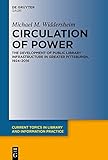Circulation of Power : The Development of Public Library Infrastructure in Greater Pittsburgh, 1924–2016 / Michael M. Widdersheim.
Material type: TextSeries: Current Topics in Library and Information PracticePublisher: Berlin ; Boston : De Gruyter Saur, [2023]Copyright date: ©2023Description: 1 online resource (VII, 270 p.)Content type:
TextSeries: Current Topics in Library and Information PracticePublisher: Berlin ; Boston : De Gruyter Saur, [2023]Copyright date: ©2023Description: 1 online resource (VII, 270 p.)Content type: - 9783111012254
- 9783111014142
- 9783111013404
- 027.074886
- online - DeGruyter
- Issued also in print.
| Item type | Current library | Call number | URL | Status | Notes | Barcode | |
|---|---|---|---|---|---|---|---|
 eBook
eBook
|
Biblioteca "Angelicum" Pont. Univ. S.Tommaso d'Aquino Nuvola online | online - DeGruyter (Browse shelf(Opens below)) | Online access | Not for loan (Accesso limitato) | Accesso per gli utenti autorizzati / Access for authorized users | (dgr)9783111013404 |
Frontmatter -- Acknowledgements -- Contents -- Preface -- Introduction -- Period 1: Periphery and Center, 1924 – 1945 -- Period 2: County Contract, 1945– 1961 -- Period 3: The Rise of District Services, 1961 – 1970 -- Period 4: Federation Revisited, 1970 – 1979 -- Period 5: Fiscal Crises and Digital Visions, 1980 – 1993 -- Period 6: The Pursuit of RAD, 1993 –1994 -- Period 7: System Dreams, 1994 – 1997 -- Period 8: Formula Wars, 1998 – 2011 -- Period 9: Compliance Culture, 2011 – 2016 -- Conclusion -- Bibliography -- List of Figures -- List of Tables -- List of Archives Consulted -- List of Acronyms -- Index
restricted access online access with authorization star
http://purl.org/coar/access_right/c_16ec
What is the public sphere, how is it best described, and what role does it play in modern life? These questions have attracted considerable attention within library and information science circles over several decades, especially regarding public libraries. Circulation of Power contributes to this discussion by proposing a new research framework and new methods for analyzing public sphere communication. Using extensive data gathered from an urban public library infrastructure, this historical case study demonstrates how public sphere communication shaped the infrastructure’s development over time, producing both changes and continuities across the case’s nine periods. Two new conceptual tools—circuits and decisions cycles—form the study’s research framework, and a new explanatory theory—RLCr, or "Releaser," theory—accounts for why the infrastructure developed as it did. Consideration of competing theories reveals that public sphere communication remains the best explanation for infrastructural development. This book’s meticulous historical narrative of the greater Pittsburgh case, supplemented by its groundbreaking theory and innovative mixed methods design, is of interest to practitioners, academics, and general readers alike.
Issued also in print.
Mode of access: Internet via World Wide Web.
In English.
Description based on online resource; title from PDF title page (publisher's Web site, viewed 06. Mrz 2024)


